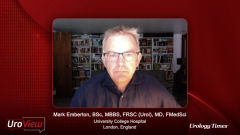
Exciting Prospects for the Future of Localized Prostate Cancer Treatment
Dr Mark Emberton shares what developments are visible on the horizon and what they represent for the future of focal therapy and treatment of clinically localized prostate cancer.
Episodes in this series

Mark Emberton, BSc, MBBS, FRSC (Urol), MD, FMedSci: The, there's been only, there has only been one revolution in the management of early prostate cancer, and that's been the ability to localize disease through MRI, and then target the biopsies, and then target therapy to the cancer. The robotic revolution was not a revolution, it was just a revolution of access. We actually did the same operation. It was a transformation but it wasn't a revolution in the way that we conceptualize or indeed treated patients and hasn't actually had a big impact in outcomes. So by far the most important event in the management of early prostate cancer in the last 100 years has been the advent of MRI to give us location, to tell us where the cancer is so that we can offer some men a reasonable, minority of men who present, a treatment to the prostate using one of the modern energy sources. And the beauty about the energy sources is that they are getting better and better at treating these cancers by exploiting location through image fusion. So when I'm treating a patient now, I import the MRI information onto the ultrasound, and then I use the ultrasound to treat. So obviously I use high intensity focused ultrasound, but with the MRI information in front of me super imposed on the ultrasound so that I'm treating to a plan based on that. So the technology associated with our treatments is improving all the time. So there's a massive revolution and that's location, and there's constant technological improvement now of the energy sources that allow us to treat these men with localized prostate cancer.
I would hope that all men would have equal access to focal therapy irrespective of their geography, their income, and their level of education. That would be my aspiration. So I would hope that all men presenting would be discussed by a multidisciplinary team that was well represented, and that could allocate the relevant treatment options to that individual, and then execute them once the options have been communicated to the patient. We're a long way from that at present. And but anyway, that's the aspiration. And I think we should really aspire to do that. And there's lots of economic sense to doing that I think. Focal therapy is the cheapest treatment that we've got. It's done as a day case. In the United States it's done under local anesthesia in an ambulatory setting without general anesthetic and patients walk in walk out. And so it, and it also means that we can treat an aging population who have clinically significant prostate cancer without recourse to systemic therapy in the form of hormones and several weeks of radiation therapy. And the hormones can have a dramatic effect on individuals. So I think we're going to see broad and fair diffusion of the technology. But I think we're gonna particularly see its application on a new group of individuals that's emerging. So these are men that are living a long time because they've not had heart disease but have developed clinically significant prostate cancer that if left untreated, could impact on their quality of life. And focal therapy in many of these individuals provides us with a wonderful way of treating the individual as a day case procedure without exposing them to systemic therapies which many of these individuals want to avoid.
So what's to come? Well I think we're still at the beginning of a story. It was only a couple of years ago April 2019 that MRI was recommended for all men. And that really opened up the door for this discussion about location and focality and focal treatment. And I think this is a story that's going to develop more and more. There will be existing technologies that will improve. There will be new technologies that will emerge. One interesting one that we're trying to get to work is to change all MRI systems in the world from diagnostic platforms to therapy platforms, by seeing if we can use the MRI to move a little bit of metal around in the prostate, and heat that bit of metal and therefore diagnose and treat within the MRI magnet. Now that's not gonna happen quickly because we're actually very experimental at this stage. But conceptually you can see once you embrace the principle of focal treatment, in other words you're after the cancer and you want to preserve healthy tissue, that it's only your imagination that holds you back. So I won't see all these developments. I'm coming towards the back of my career. So I'm very excited when I chat to young urologists starting out in this area because I think it's gonna be a very, very exciting time for them.
Newsletter
Stay current with the latest urology news and practice-changing insights — sign up now for the essential updates every urologist needs.




















